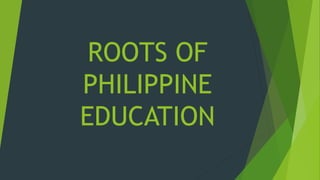
4 Roots of Philippine Education
- 2. Contents: Before 1521- Pre- Hispanic Time 1521-1896- Spanish Regime 1898-1935- American Period 1935-1941- Commonwealth Period 1941-1944- Japanese Occupation After WWII- Present
- 3. Pre-Hispanic Time Education was both informal and unstructured. Education was taught orally, practical, and hands-on Filipino men and women knows how to read and write using their own alphabet called alibata.
- 4. Educational System during the Spanish Period The principal aim was to make native Filipinos obedient and God-fearing Christians. The educational system is formal. There were separate schools for boys (colegios) and girls (beaterios). Religion was a compulsory subject at all levels. The schools focused on the Christian Doctrine. Education was managed, supervised, and controlled by the friars. Reading, writing, arithmetic and some vocational and practical arts subjects were taught. History, Latin, geography and philosophy were taught as well. During the early part of 17th century, colleges and universities were only open to the Spaniards and those with Spanish blood (meztizos). In 19th century, Education decree 1863 required the government to provide school institutions in every town (public schools) thus Filipino students were already accepted.
- 5. Educational System during the American Period The principal goal was to educate and to train in the science of self-government. Educating the Filipinos was one of their top priorities. Americans made it a point to teach English to the Filipinos and American soldiers were the first teachers. Trained teachers replaced soldiers. Filipinos warmly received their new teachers, Thomasites In January 1901, free primary education was provided and a school for Filipino teachers were established. Pensionados- they were bright Filipino students who were given the opportunity to take up higher education in American colleges and universities. Compulsory religious instructions were abolished. Educational Act 1901 “Separation of Church and State in Education”
- 6. Education under the Commonwealth In accordance with the 1935 constitution, the Commonwealth provided free education in public schools all over the country. President Quezon created the National Council of Education in 1936. Vocational and adult education were given emphasis President Quezon issued the EO No. 217 – Quezon’s Code of Ethics which was required to be taught in all schools. In 1940, changes were made in the country’s educational system by virtue of Educational Act of 1940.
- 7. Changes in Education during the Japanese Occupation Changes were made in the system of education in February 1942, these changes were: • To stop depending on western countries like the U.S., and Great Britain. Promote and enrich the Filipino culture. • To recognize that the Philippines is a part of the Greater East Asia Co- Prosperity Sphere so that the Philippines and Japan will have good relations. Japanese Catholic priests were sent to the Philippines to help promote the idea that Japan, being an Asian country, was a friend to all Asian people including the Filipinos. • To learn and adopt Nippongo and to stop using the English language. Nippongo was made compulsory subjects in all schools. • To spread elementary and vocational education. • To inspire people with the spirit to love neighbor (patriotism).
- 8. Education System During Martial Law The Department of Education became the: 1972- Department of Education and Culture 1978- Ministry of Education and Culture 1982- Ministry of Education, Culture, and Sports A bilingual education scheme was established in 1974, requiring English and Filipino to be used in schools. Science and Math subjects as well as English language and literature classed were taught in English while the rest were taught in Filipino.
- 9. Educational System in the Present Period In 1994, Congress passed the Republic Act 7722 and Republic Act 7796 creating the Commission on Higher Education (CHED) and the Technical Education and Skills Development Authority (TESDA). The institute governing basic education was thus renamed in 2001 as the Department of Education (DepEd). Philippine education is patterned after the American system, with English as the medium of instruction. Schools are classified into public or private.
- 10. The general pattern of formal education follows four stages: o Pre-primary level, (nursery, kindergarten and preparatory) offered in most private schools; o Primary education, six years o Secondary education, four years. o College education usually takes four, sometimes five and in some cases as in medical and law schools, as long as eight years. o Graduate schooling is an additional two or more years. Classes start in June and end in March. Colleges and universities follow the semestral calendar from June-October and November- March.
- 11. • The K to 12 Program covers 13 years of basic education with the following key stages: • Kindergarten to Grade 3 • Grades 4 to 6 • Grades 7 to 10 (Junior High School) • Grades 11 and 12 (Senior High School)
- 14. THANK YOU Emily F. Mijares
